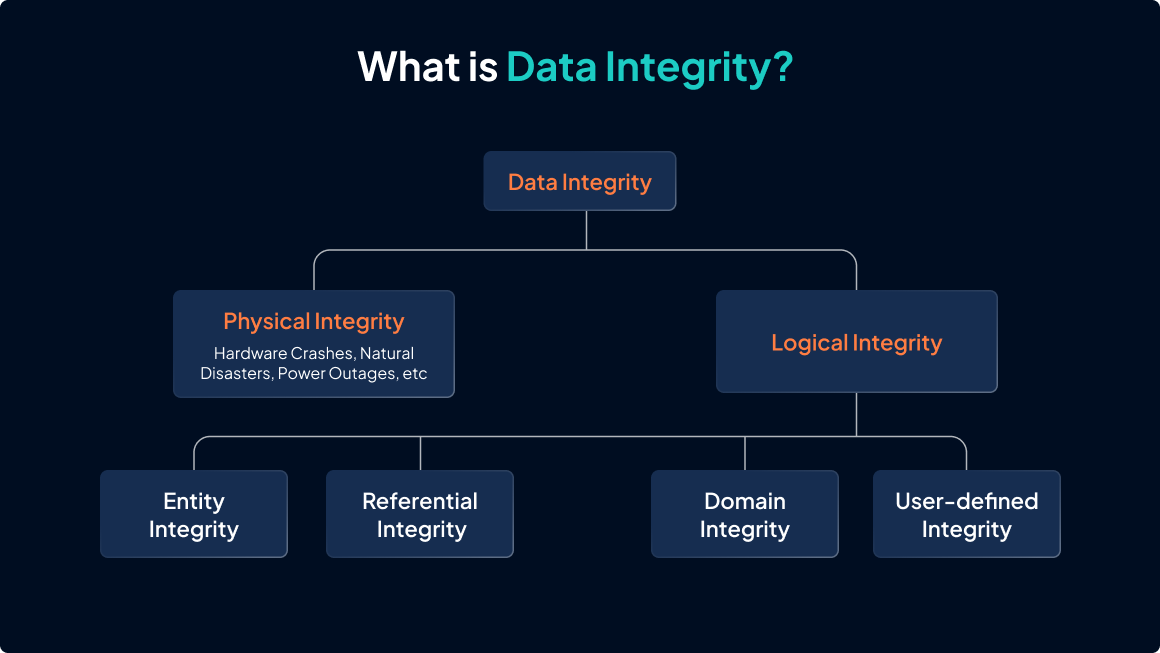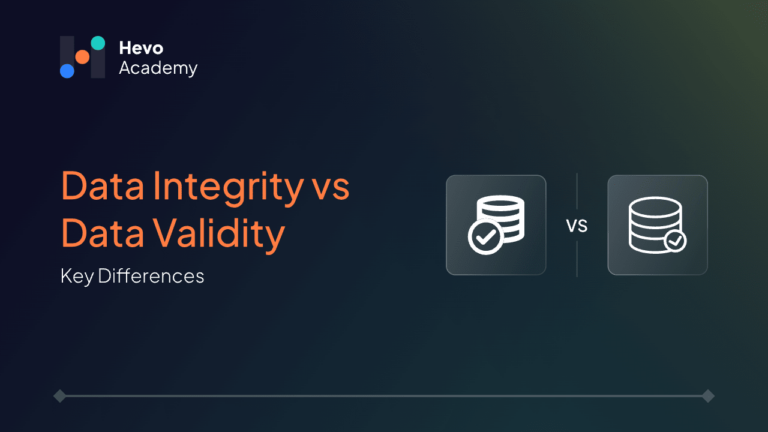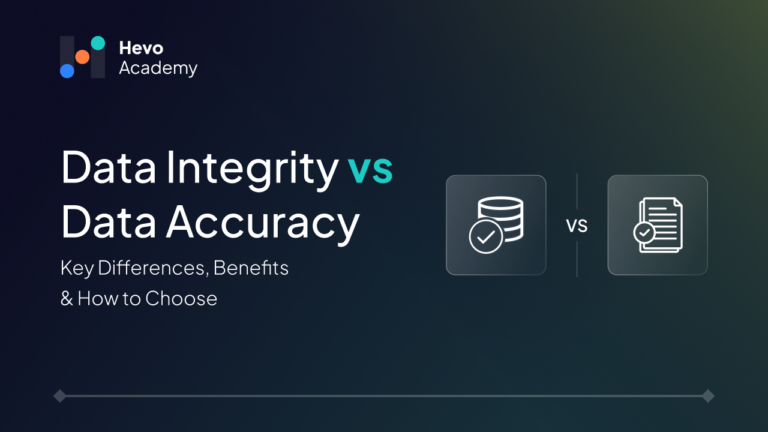Accurate and reliable data is important in every business and organization. Data integrity means keeping data accurate and consistent throughout the data lifecycle. It is about making sure that data and information stay free from errors, inconsistencies, and unauthorized changes. This write-up will explain what is data integrity, why it matters, and how you can maintain it.
Table of Contents
What Is Data Integrity?
Data integrity is data’s accuracy, completeness, consistency, and validity over its entire life cycle. This process ensures that data and information remain reliable, usable, and unchanged from when they are created or collected until archived or deleted. Data integrity is an important aspect of data management within a system like a database.
Why Is Data Integrity Important?
- Data integrity can spare an organization the effort, time, and money it would cost to make a decision based on incomplete and incorrect data because data-driven decisions can only be as strong as those based on the data.
- It is important because it ensures the consistency, completeness, and accuracy of data, which is critical for making credible decisions based on that data. If the data is not reliable due to inaccuracies or inconsistencies, it can lead to wrong decision-making, financial consequences, and operational inefficiencies for an organization.
- Data integrity guarantees and secures the searchability and traceability of your data to its source.
- It protects your data subject image and information. Data integrity should be prioritized from the design and implementation stage of your system to safeguard your platforms’ stability and performance.

Types of Data Integrity
Data integrity can be classified into two major types, namely;
Physical Integrity
This data integrity deals with the physical safety and accessibility of your data. It makes sure that data are protected from physical damage, loss, or destruction due to factors like;
- Hardware crashes: These involve crashes of computer servers, storage devices, or network equipment.
- Natural disasters: These include earthquakes, floods, or fires, which could damage the physical storage devices where your data is stored.
- Power outages: This includes unexpected power surges and failures. If data are not stored and backed up properly, the power surges could cause data loss.
Logical Integrity
This type deals with the accuracy and consistency of the data itself. Here are a few key aspects:
- Entity Integrity: Entity integrity refers to the principle in a database management system that ensures each row in a database table has a unique and non-null primary key value. This ensures that every record in a table can be uniquely identified, and duplicate entries can be prevented by enforcing the use of a primary key to identify each row for data integrity and consistency.
- Referential Integrity: This is a database concept that maintains relationships between the tables in a relational database like MySQL or PostgreSQL. It also ensures that foreign keys in one table correspond to valid primary keys in another table. For example, ensure that every order references a valid customer in a sales database.
- Domain Integrity: This data integrity ensures that data values fall within defined organization rules for a particular field or column. For example, a “date of birth” column can be restricted to valid calendar dates only.
- User-Defined Integrity: User-defined integrity detects errors that domain referential and entity integrity do not. It creates custom rules and constraints to ensure data is used in a specific way and triggers when specific events occur.
In simpler terms, data integrity ensures that your data is reliable and trustworthy, just like you want your information to be accurate and dependable in your everyday life.
Data Integrity vs Data Quality vs Data Security
| Data Integrity | Data Quality | Data Security |
| Data integrity ensures that data remains accurate, consistent, reliable, unaltered, and free from corruption throughout its lifecycle. | Data quality is the overall fitness for the use of data because it focuses on attributes like relevance, timeliness, consistency, completeness, and accuracy of data. | Data security involves protecting data from corruption, theft, and unauthorized access to safeguard data confidentiality and prevent breaches. |
You can also take a look at the detailed differences between data quality vs data integrity and data validity vs data integrity.
How to Ensure the Integrity of Data?
- Validating Data Input: Organizations must ensure that they vet and validate the sources from which they get data, especially if the data comes from third-party sources or other applications. They must make sure that the data sourced meets predefined conditions for format.
- Data Entry Training: One of the biggest problems organizations face in maintaining data integrity is that their employees are not well-trained in data management. Organizations must train their employees on entering and maintaining data and delegate them the responsibility of preserving the data quality.
- Using Access Control: The chances of a data integrity breach increase when there is no access control in your organization. This oftentimes leads individuals with no access and hostile intent to gain access to your data and do grievous harm to your organization. That is why it is important to exercise access control, implement a privilege model, and give access to only those users who need it so that there is high-level control and data integrity can be preserved.
- Backing Up Data: Backing up data helps prevent the risk of permanently losing data. Data backup plays a critical role in bringing everything back to normal and preserving the integrity of the data. In choosing a cloud storage and backup solution, you need to be careful because most providers are not what they claim to be.
- Performing Penetration Testing and Security Audits: Penetration testing is another way of checking data integrity. It involves having an ethical hacker try to hack into your organization’s database and find its vulnerabilities. This helps you see where you are lacking and fix the problem.
You can also take a look at our detailed guide on data integrity best practices to learn how to ensure accuracy and reliability in your data pipelines.
What Are Some Data Integrity Risks?
- Human Error: Human error is a significant risk to organizations’ data integrity. It is sometimes caused by users entering incorrect data, duplicating data, deleting data, making mistakes with procedures, or not following protocols to protect information.
- Transfer Error: A transfer error occurs when data cannot be transferred between database locations. It occurs when data is in a table but not the source table of a relational database.
- Viruses and Bugs: Hackers threaten organizations’ data integrity by using spyware, malware, and viruses to attack computers in an attempt to amend, steal, or delete user data.
- Hardware and Software Issues: Hardware and software issues can compromise data when you store, process, and transfer it. Software malfunctioning usually leads to unupdated and unsecured data. Hardware problems primarily relate to physical integrity.
- Security Issues: This includes security misconfigurations that hackers can exploit to breach your system and compromise your data integrity.
Real-World Use of Cases of Data Integrity
- System Stability: Data integrity helps to maintain the stability of the database and information by preventing errors that could cause malfunction.
- Accurate Decision-Making: It allows organizations to make good business decisions across various sectors, such as finance, healthcare, and government.
- Operational Efficiency: Consistent and accurate data minimize errors and disruptions in operations, leading to improved efficiency.
- Customer Trust and Reputation: It helps build customer trust and maintain a positive company image
Conclusion
Data integrity ensures that information used for decision-making is accurate, trustworthy, reliable, and valid. Maintaining data integrity helps organizations run their operation smoothly as it minimizes error. It also means implementing practices like data validation, regular backup, access control, audit trails, and encryption to prevent data alterations and unauthorized access.
Try a 14-day free trial and experience the feature-rich Hevo suite firsthand. Also, check out our unbeatable pricing to choose the best plan for your organization.
FAQs
1. What are the seven principles of data integrity?
There are seven principles of data integrity based on the GDPR (General Data Protection Regulation). They are;
– Lawfulness, Fairness, and Transparency,
– Purpose Limitation
– Data Minimization
– Accuracy
– Storage Limitation
– Integrity and Confidentiality
– Accountability
2. What are the four types of data integrity?
The four types of data integrity are entity integrity, referential integrity, domain integrity, and user-defined integrity.
3. What are the three rules of data integrity?
The three rules of data integrity are consistency, completeness, and accuracy; that is, data must have all necessary information, must be correct, and must maintain a uniform format throughout its lifecycle.






